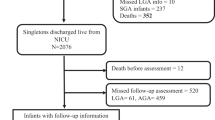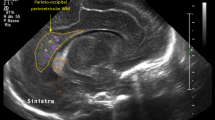Abstract
OBJECTIVE: To compare the results of neurosonography (NSG) with subsequent neurodevelopmental testing in extremely low birth weight (ELBW; ≤1000 g) neonates.
STUDY DESIGN: NSG at hospital discharge was available in 164 neonates and Bayley Scores of Infant Development (BSID II) evaluations (MDI and PDI) were performed in 158 of these infants at 18 to 22 months. Neurosonographic studies obtained prior to the discharge study also were evaluated. Neurosonograms were interpreted by pediatric radiologists, and BSID II examinations were performed by certified examiners masked to the results of the neurosonographic studies.
RESULTS: A normal sonographic study at discharge was observed in 44% (14/32) of neonates with MDI <70 and 29% (7/24) with PDI <70. Furthermore, the sonographic study at discharge was normal in 59% (36/61) of neonates with MDI 70 to 84 and 56% (31/55) with PDI 70 to 84. Conversely, approximately 30 to 40% of those with an abnormality noted on neurosonogram at discharge, or at any time during hospitalization, had MDI and/or PDI scores ≥85. The association between abnormal NSG at discharge and low BSID II results was stronger for the PDI exam compared with the MDI exam.
CONCLUSION: These results emphasize the limitations of NSG in predicting subsequent neurodevelopmental outcome in ELBW neonates. The primary role for NSG in ELBW neonates may be in the diagnosis and management of acute problems, such as intraventricular hemorrhage and posthemorrhagic hydrocephalus, and not as a tool to predict subsequent outcome.
This is a preview of subscription content, access via your institution
Access options
Subscribe to this journal
Receive 12 print issues and online access
$259.00 per year
only $21.58 per issue
Buy this article
- Purchase on Springer Link
- Instant access to full article PDF
Prices may be subject to local taxes which are calculated during checkout

Similar content being viewed by others
References
Dubowitz LM, Bydder GM, Mushin J . Developmental sequence of periventricular leukomalacia. Correlation of ultrasound, clinical, and nuclear magnetic resonance functions. Arch Dis Childhood 1985;60:349–355.
Guzzetta F, Shackelford G, Volpe S, Perlman J, Volpe J . Periventricular intraparenchymal echodensities in the premature newborn: critical determinant of neurologic outcome. Pediatrics 1986;78:995–1006.
Jongmans M, Mercuri E, de Vries L, Dubowitz L, Henderson SE . Minor neurological signs and perceptual-motor difficulties in prematurely born children. Arch Dis Childhood/ Fetal Neonatal Ed 1997;76:F9–14.
Weindling AM, Rochefort MF, Calvert SA, Fok TF, Wilkinson A . Development of cerebral palsy after ultrasonographic detection of periventricular cysts in the newborn. Dev Med & Child Neurol 1985;27:800–806.
De Vries LS, Dubowitz LM, Dubowitz V et al. Predictive value of cranial ultrasound in the newborn baby: a reappraisal. Lancet 1985;2(8447):137–140.
Stewart AL, Reynolds EO, Hope PL et al. Probability of neurodevelopmental disorders estimated from ultrasound appearance of brains of very preterm infants. Dev Med Child Neurol 1987;29:3–11.
Ment LR, Scott DT, Ehrenkranz RA, Duncan CC . Neurodevelopmental assessment of very low birthweight neonates: effect of germinal matrix on intraventricular hemorrhage. Pediatr Neurol 1985;1:164–168.
Whitaker AH, Feldman JF, Van Rossem R et al. Neonatal cranial ultrasound abnormalities in low birth weight infants: relation to cognitive outcomes at six years of age. Pediatrics 1996;98:719–729.
Paul DA, Pearlman SA, Finkelstein MS, Stefano JL . Cranial sonography in very-low-birth-weight infants: do all infants need to be screened? Clin Pediatr 1999;38:503–509.
Bennett FC, Silver G, Leung EJ, Mack LA . Periventricular echodensities detected by cranial ultrasonography: usefulness in predicting neurodevelopmental outcome in low-birth-weight, preterm infants. Pediatrics 1990;85:400–404.
Maalouf EF, Duggan PJ, Counsell SJ, et al. Comparison of findings on cranial ultrasound and magnetic resonance imaging in preterm infants. Pediatrics 2001;107:719–727.
Ng PC, Dear PR . The predictive value of a normal ultrasound scan in the preterm baby — a meta analysis. Acta Paediatr Scand 1990;79:286–291.
Rennie JM . Cranial Ultrasound Imaging and Prognosis. Cambridge: Cambridge University Press; 1997.
Sanchez AM, Mize SG, Jimenez JM et al. Systems approach to the evaluation of maternal and neonatal care. In: Twelfth Hawaii International Conference on System Sciences, Selected Papers in Medical Information Processing; 1979; pp. 140–151.
Tyson JE, Kennedy K, Broyles RS, Rosenfeld CR . The small for gestational age infant: accelerated or delayed pulmonary maturation? Increased or decreased survival? Pediatrics 1995;95:534–538.
Hernandez C, Little BB, Dax JS, Gilstrap LCI, Rosenfeld CR . Prediction of the severity of meconium aspiration syndrome. Am J Obstet Gynecol 1993;169:61–70.
Papile LA, Burstein J, Burstein R, Koffler H . Incidence and evolution of subependymal and intraventricular hemorrhage: a study of infants with birth weights less than 1,500 gm. J Pediatrics 1978;92:529–534.
Perlman JM, Rollins N . Surveillance protocol for the detection of intracranial abnormalities in preterm neonates. Arch Pediatr Adolesc Med 2000;154:822–826.
Sackett KL, Haynes RB, Guyatt GH, Tugwell P . Clinical Epidemiology. 2nd ed. Boston/Toronto/London: Little, Brown and Company; 1991.
Ment LR, Bada HS, Barnes MD, et al. Practice parameter: neuroimaging of the neonate. Neurology 2002;58:1726–1738.
Satter JM . Assessment of Children's Intelligence and Special Abilities. 2nd ed. Boston, MA: Allyn and Bacon Inc.; 1981.
Volpe JJ . Brain injury in the premature infant: overview of clinical aspects, neuropathology, and pathogenesis. Semin Pediatr Neurol 1998;5:135–151.
Hope PL, Gould SJ, Howard S, Hamilton PA, Costello AM, Reynolds EO . Precision of ultrasound diagnosis of pathologically verified lesions in the brains of very preterm infants. Dev Med Child Neurol 1988;30:457–471.
Paneth N, Rudelli R, Monte W, et al. White matter necrosis in very low birth weight infants: neuropathologic and ultrasonographic findings in infants surviving six days or longer. J Pediatrics 1990;116:975–984.
Carson SC, Hertzberg BS, Bowie JD, Burger PC . Value of sonography in the diagnosis of intracranial hemorrhage and periventricular leukomalacia: a postmortem study of 35 cases. Am J Neuroradiol 1990;11:677–683.
Leviton A, Paneth N . White matter damage in preterm newborns—an epidemiologic perspective. Early Hum Dev 1990;24:1–22.
Armstrong DL, Bagnall C, Harding JE, Teele RL . Measurement of the subarachnoid space by ultrasound in preterm infants. Arch Dis Childhood/Fetal Neonatal Ed 2002;86:F124–F126.
Wilson-Costello D, Borawske E, Friedman H, Redline R, Fanaroff AA, Hack M . Perinatal correlates of cerebral palsy and other neurologic impairment among very low birth weight children. Pediatrics 1998;102:315–322.
van de Bor M, den Ouden L, Guit G . Value of cranial ultrasound and magnetic resonance imaging in predicting neurodevelopmental outcome in preterm infants. Pediatrics 1992;90:196–199.
Bennett F, Silver G, Leung E, Mack L . Periventricular echodensities detected by cranial ultrasonography: usefulness in predicting neurodevelopmental outcome in low-birth-weight, preterm infants. Pediatrics 1990;85:400–404.
Vohr BR, Wright LL, Dusick AM, Mele L, Verter J, Steichen JJ . Neurodevelopmental and functional outcomes of extremely low birth weight infants in the National Institute of Child Health and Human Development Neonatal Research Network, 1993–1994. Pediatrics 2000;105:1216–1226.
Acknowledgements
We appreciate the secretarial assistance of Marilyn Dixon in preparation of the manuscript.
Author information
Authors and Affiliations
Corresponding author
Additional information
Presented in part at the Pediatric Academic Societies Meeting, May 5, 2002, Baltimore, MD, USA.
Rights and permissions
About this article
Cite this article
LeFlore, J., Sue Broyles, R., Pritchard, M. et al. Value of Neurosonography in Predicting Subsequent Cognitive and Motor Development in Extremely Low Birth Weight Neonates. J Perinatol 23, 629–634 (2003). https://doi.org/10.1038/sj.jp.7211009
Published:
Issue Date:
DOI: https://doi.org/10.1038/sj.jp.7211009



